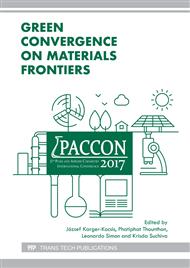[1]
S. Baltova, V. Vassileva, Photochemical behaviour of natural silkeII. Mechanism of fibroin photodestruction, Polym. Degrad. Stab. 60 (1998) 61-65.
DOI: 10.1016/s0141-3910(98)80027-x
Google Scholar
[2]
A. Martel, M. Burghammer, R.J. Davies, C. Riekel, Thermal behavior of bombyx mori silk: evolution of crystalline parameters, molecular structure, and mechanical properties, Biomacromolecules. 8 (2007) 3548-3556.
DOI: 10.1021/bm700935w
Google Scholar
[3]
K. Numata, P. Cebe, D.L. Kaplan, Mechanism of enzymatic degradation of beta sheet crystals, Biomaterials. 31 (2010) 2926-2933.
DOI: 10.1016/j.biomaterials.2009.12.026
Google Scholar
[4]
D. Sargunamani, N. Selvakumar, A study on the effects of ozone treatment on the properties of raw and degummed mulberry silk fabrics, Polym. Degrad. Stab. 91 (2006) 2644-2653.
DOI: 10.1016/j.polymdegradstab.2006.05.001
Google Scholar
[5]
J.Z. Shao, Z.H. Zheng, J.Q. Liu, C.M. Carr, Fourier transform Raman and Fourier transform infrared spectroscopy studies of silk fibroin, J. Appl. Polym. Sci. 96 (2005) 1999-(2004).
DOI: 10.1002/app.21346
Google Scholar
[6]
X.M. Zhang, P. Wyeth, Moisture sorption as a potential condition marker for historic silks: noninvasive determination by near-infrared spectroscopy, Appl. Spectrosc. 61 (2007) 218-222.
DOI: 10.1366/000370207779947611
Google Scholar
[7]
K. Kavkler, N. Gunde-Cimerman, P. Zalar, A. Dem_sar, FTIR spectroscopy of biodegraded historical textiles, Polym. Degrad. Stab. 96 (2011) 574-580.
DOI: 10.1016/j.polymdegradstab.2010.12.016
Google Scholar
[8]
S. Greiff, H. Kutzke, C. Riekel, P. Wyeth, S. Lahlil. J. Rob, W. Paul, Scientific analysis of ancient and historic textiles, Archetype, London, 2004. p.38.
Google Scholar
[9]
A.C. Hermes, R.J. Davies, S. Greiff, H. Kutzke, S. Lahlil, P. Wyeth, et al., Characterizing the decay of ancient Chinese silk fabrics by microbeam synchrotron radiation diffraction, Biomacromolecules. 7 (2006) 777-783.
DOI: 10.1021/bm0508313
Google Scholar
[10]
X. Luo, J. Wu, A. Intisar, J. Geng, L. Wu, K. Zheng, Y. Du, Study on Light Aging of Silk Fabric by Fourier Transform Infrared Spectroscopy and Principal Component Analysis, Anal. Lett. 45 (2012) 1286–1296.
DOI: 10.1080/00032719.2012.673098
Google Scholar
[11]
P. Taddei, P. Monti, G. Freddi, T. Arai, M. Tsukada, IR study on the binding mode of metal cations to chemically modified Bombyx mori and Tussah silk fibres, J. Mol. Struct. 651–653 (2003) 433–441.
DOI: 10.1016/s0022-2860(02)00663-4
Google Scholar
[12]
A. Sionkowska, A. Planecka, The influence of UV radiation on silk fibroin, Polym. Degrad. Stab. 96 (2011) 523–528.
DOI: 10.1016/j.polymdegradstab.2011.01.001
Google Scholar
[13]
B. Stuart, Modern infrared spectroscopy, in: Organic Compounds, John Wiley & Sons Ltd., West Sussex, 1996, p.97–108.
Google Scholar
[14]
P. Garside, P. Wyeth, Crystallinity and degradation of silk: correlations between analytical signatures and physical condition on ageing, Appl. Phys. A. Mater. 89 (2007) 871-876.
DOI: 10.1007/s00339-007-4218-z
Google Scholar
[15]
E. Bramanti, D. Catalano, C. Forte, M. Giovanneschi, M. Masetti, C. A. Veracini, Solid state (13)C NMR and FT-IR spectroscopy of the cocoon silk of two common spiders, Spectrochim. Acta. A. 62 (2005) 105-111.
DOI: 10.1016/j.saa.2004.12.008
Google Scholar
[16]
H. Fabina, W. Mantele, Infrared spectroscopy of proteins, in: Handbook of vibrational spectroscopy, John Wiley & Sons, (2006).
Google Scholar
[17]
G. Socrates, editor, Infrared and Raman characteristic group frequencies: tables and charts, third ed., John Wiley & Sons, (2004).
DOI: 10.1002/jrs.1238
Google Scholar
[18]
M.M.R. Khan, H. Morikawa, Y. Gotoh, M. Miura, Z. Ming, Y. Sato, et al., Structural characteristics and properties of Bombyx mori silk fiber obtained by different artificial forcibly silking speeds, Int. J. Biol. Macromol. 42 (2008) 64-70.
DOI: 10.1016/j.ijbiomac.2007.12.001
Google Scholar
[19]
A.R. Murphy, P. St. John, D.L. Kaplan, Modification of silk fibroin using diazonium coupling chemistry and the effects on hMSC proliferation and differentiation, Biomaterials. 29 (2008) 2829-2838.
DOI: 10.1016/j.biomaterials.2008.03.039
Google Scholar
[20]
P. Taddei, P. Monti, G. Freddi, T. Arai, M. Tsukada, IR study on the binding mode of metal cations to chemically modified Bombyx mori and Tussah silk fibres, J. Mol. Struct. 651-653 (2003) 433-441.
DOI: 10.1016/s0022-2860(02)00663-4
Google Scholar
[21]
R.S. Davidson, The photodegradation of some naturally occurring polymers, J. Photochem. Photobiol. B. 33 (1996) 3-25.
Google Scholar
[22]
M. Boulet-Audet, T. Lefèvre, H. Buffeteau, M. Pézolet, Attenuated Total Reflection Infrared Spectroscopy: An Efficient Technique to Quantitatively Determine the Orientation and Conformation of Proteins in Single Silk Fibers, Appl. Spectrosc. 62 (2008).
DOI: 10.1366/000370208785793380
Google Scholar
[23]
S. Ling, Z. Qi, D.P. Knight, Z. Shao, X. Chen, Synchrotron FTIR Microspectroscopy of Single Natural Silk Fibers, Biomacromolecules. 12 (2011) 3344–3349.
DOI: 10.1021/bm2006032
Google Scholar
[24]
T. Lefèvre, F. Paquet-Mercier, S. Lesage, M. -E. Rousseau, S. Bédard, M. Pézolet, Study by Raman spectromicroscopy of the effect of tensile deformation on the molecular structure of Bombyx mori silk, Vib. Spectrosc. 51 (2009) 136–141.
DOI: 10.1016/j.vibspec.2008.11.012
Google Scholar
[25]
P. Monti, P. Taddei, G. Freddi, T. Asakura, M. Tsukada, Raman spectroscopic characterization of Bombyx mori silk fibroin: Raman spectrum of Silk I, J. Raman Spectrosc. 32 (2001) 103–107.
DOI: 10.1002/jrs.675
Google Scholar
[26]
M.A. Koperska, D. Pawcenis, J. Bagniuk, M.M. Zaitz, M. Missori, T. Łojewski,J. Łojewska, Degradation markers of fibroin in silk through infrared spectroscopy, Polymer Degradation and Stability. 105 (2014) 185-196.
DOI: 10.1016/j.polymdegradstab.2014.04.008
Google Scholar
[27]
B. Marelli, A. Alessandrino, S. Farè, G. Freddi, D. Mantovani, M. C. Tanzi, Compliant electrospun silk fibroin tubes for small vessel bypass grafting, Acta. Biomater. 6 (2010) 4019-4026.
DOI: 10.1016/j.actbio.2010.05.008
Google Scholar
[28]
X.X. Feng, L. Zhou, H.L. Zhu, and J.Y. Chen, Study on the properties of nano-TiO2 particles modified silk fibroin porous film, J. Appl. Polym. Sc. 116 (2010) 468–472.
Google Scholar
[29]
W.L. Xu, G.Z. Ke and X.Q. Peng, Studies on the effects of the enzymatic treatment on silk fine powder, J. Appl. Polym. Sc. 101 (2006) 2967–2971.
DOI: 10.1002/app.23529
Google Scholar
[30]
Q.Q. Yuan, J.R. Yao, X. Chen, L. Huang, and Z.Z. Shao, The preparation of high performance silk fiber/fibroin composite, Polymer. 51 (2010) 4843–4849.
DOI: 10.1016/j.polymer.2010.08.042
Google Scholar


